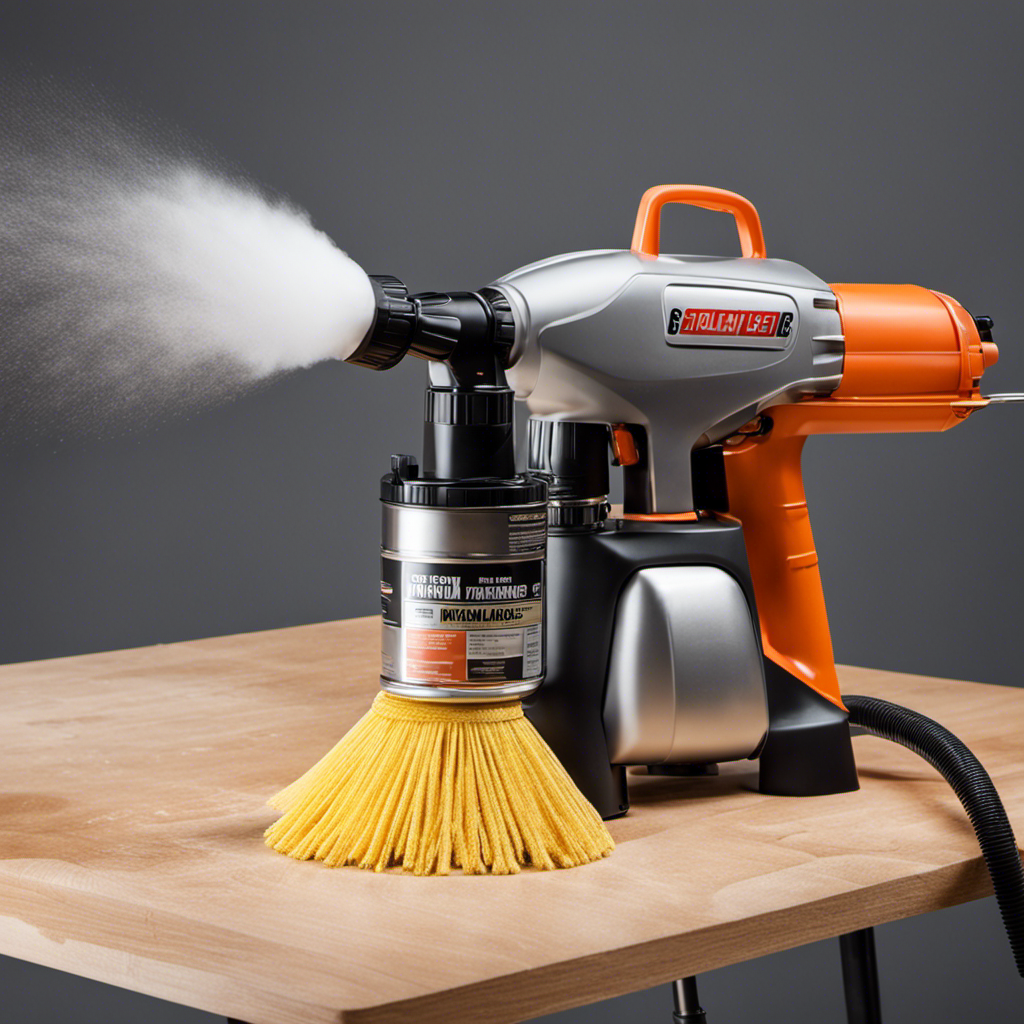To spray a patterned feature wall, start by preparing your space with drop cloths and painter’s tape to protect areas and outline your design. Practice spray gun techniques to achieve even coverage and crisp lines, moving steadily and overlapping passes. Mask intricate patterns with tape or stencils, then apply light coats of spray paint, building up color gradually. Carefully remove masking for sharp edges, and if you keep practicing, you’ll master creating stunning, professional-looking patterned walls.
Key Takeaways
- Sketch your desired pattern on the wall with pencil or chalk before spraying.
- Use painter’s tape or stencils to mask areas for clean, crisp pattern edges.
- Practice spray gun techniques on scrap material for even coverage and proper distance.
- Apply multiple light coats, moving the spray gun steadily to prevent drips and overspray.
- Carefully remove masking tape after painting to reveal sharp, professional-looking patterns.

Ever wondered how to create a stunning patterned feature wall with spray paint? The key lies in mastering spray gun techniques and effective pattern masking. With the right approach, you can transform a plain wall into a captivating focal point that reflects your style. The process begins with preparing your workspace: protect the surrounding areas with drop cloths, tape off edges, and ensure the wall is clean and smooth. Once you’re ready, select the spray paint colors and the appropriate spray gun for your project. Using a spray gun, you’ll need to practice spray gun techniques to achieve even coverage and crisp lines. Hold the gun at a consistent distance—about 6 to 12 inches from the wall—and move smoothly in steady, overlapping passes. Keep your hand steady and avoid stopping mid-spray to prevent uneven patches or drips. Adjust the spray pattern to suit the design, whether you’re aiming for a fine mist or a broader spray, to control the amount of paint and avoid overspray.
Pattern masking is vital for creating clean, precise shapes. First, sketch your pattern directly onto the wall with a pencil or light chalk outline. Use painter’s tape or specialized masking tape to cover areas you don’t want painted. For intricate patterns, consider using stencils cut from cardboard or adhesive stencils that can be easily repositioned. When applying pattern masking, press down edges firmly to prevent paint bleed under the tape, which can ruin sharp lines. Layering tape can help create complex designs, and always double-check the alignment before starting to spray. For more detailed areas, you might use smaller brushes or sponges to touch up edges after spraying. Be patient and take your time to ensure each section is masked accurately; rushing can cause smudging or uneven lines.
Once you’ve masked the pattern and practiced your spray gun techniques, start your spraying process with light, even coats. Build up the color gradually to avoid drips and ensure sharp, clean edges on your pattern. Always keep the gun moving—pausing too long in one spot can cause paint buildup. After completing each section, carefully remove the masking tape before the paint dries to reveal crisp, defined lines. If needed, touch up any imperfections with a small brush. With patience and attention to detail, your patterned feature wall will stand out beautifully, showcasing your skills in spray gun techniques and pattern masking. Remember, practice makes perfect, so take your time and enjoy the creative process.
Frequently Asked Questions
What Type of Spray Gun Is Best for Detailed Patterns?
For detailed pattern techniques, you should use a fine-detail spray gun, like a gravity feed or airbrush. These spray gun types give you precise control over paint flow and spray pattern, allowing you to create intricate designs. Airbrushes are especially ideal for delicate, detailed work because they offer adjustable needles and nozzles. With the right spray gun, you can achieve clean, sharp patterns easily on your feature wall.
How Do I Prevent Paint From Bleeding Under Tape?
To keep your paint crisp, gently seal the edges with edge sealing tape before spraying. Make sure the tape adheres firmly, then spray your pattern carefully. When it’s time to remove the tape, do so slowly and at a sharp angle to prevent any paint from bleeding underneath. Proper tape removal and edge sealing make your design look clean, professional, and sharp—no unwanted smudges or bleeding.
Can I Use Stencils With a Spray Gun?
Yes, you can use stencils with a spray gun, but you need to follow specific spray gun tips for best results. Keep the stencil design flat and secure to prevent paint bleed, and hold the spray gun at a consistent distance, about 6-12 inches away. Use light, even coats, and move smoothly to avoid overspray. Proper technique guarantees clean, sharp patterns and a professional finish.
What Safety Gear Should I Wear During Spraying?
Imagine you’re tackling a pattern spray project, and safety is key. You should wear protective clothing like goggles, a mask, and gloves to shield your skin and eyes from fumes and overspray. Make certain proper ventilation precautions, such as working in a well-ventilated area or using fans, to prevent inhaling harmful particles. These safety measures help you spray confidently while minimizing health risks.
How Do I Correct Mistakes or Uneven Patterns?
If you notice mistakes or uneven patterns, start by letting the paint dry completely. Use touch-up techniques like a small brush or sponge to carefully blend these areas, ensuring pattern consistency. Lightly sand any rough spots if necessary before re-spraying. Always work in thin, even coats, and check your pattern regularly to maintain uniformity. Patience and attention to detail help you correct errors without damaging the overall design.
Conclusion
Think of your feature wall as a blank canvas waiting to tell its story. With your spray patterns, you’re like a skilled artist bringing a vibrant mural to life—each spray a brushstroke of personality. Embrace the process, and remember, even the most intricate designs are just a series of simple steps. When you’re done, step back and admire your masterpiece, knowing you’ve turned a plain wall into a mesmerizing work of art.
Franz came aboard the Paint Sprayer Zone team with a background in both journalism and home renovation. His articulate writing style, combined with a passion for DIY projects, makes him an invaluable asset. Franz has a knack for breaking down technical jargon into easy-to-understand content, ensuring that even the most novice of readers can grasp the complexities of paint sprayers.










